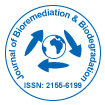Microbial Mechanisms in Heavy Metal Bioremediation: A Sustainable Approach to Environmental Cleanup
Received Date: Mar 03, 2025 / Accepted Date: Mar 30, 2025 / Published Date: Mar 30, 2025
Abstract
Heavy metal contamination of soil and water bodies has become a significant environmental issue due to industrial activities, mining, and urbanization. Traditional methods of remediation, such as chemical precipitation and physical extraction, often present high costs, limited efficiency, and environmental risks. In contrast, bioremediation, particularly through microbial mechanisms, offers a more sustainable and cost-effective solution. Microorganisms possess various metabolic pathways that enable them to detoxify, transform, or immobilize toxic heavy metals, making them invaluable in addressing contamination. This review explores the microbial mechanisms involved in heavy metal bioremediation, including bioaccumulation, biosorption, and biotransformation. Additionally, the challenges and future directions of microbial bioremediation are discussed, emphasizing the need for advanced research to optimize and scale this technique for environmental cleanup.
Citation: © 2025 Horsecar E. This is an open-access article distributed underthe terms of the Creative Commons Attribution License, which permits unrestricteduse, distribution, and reproduction in any medium, provided the original author andsource are credited.
Copyright: Horsecar E (2025) Microbial Mechanisms in Heavy Metal Bioremediation:A Sustainable Approach to Environmental Cleanup. J Bioremediat Biodegrad, 16:671.
Select your language of interest to view the total content in your interested language
Share This Article
Recommended Journals
Open Access Journals
Article Usage
- Total views: 271
- [From(publication date): 0-0 - Nov 11, 2025]
- Breakdown by view type
- HTML page views: 210
- PDF downloads: 61
